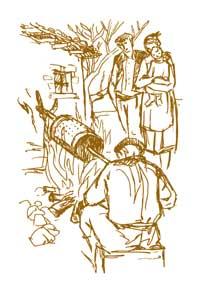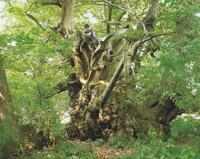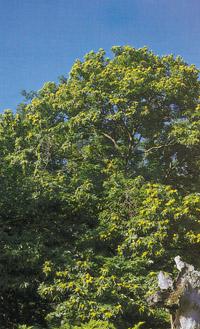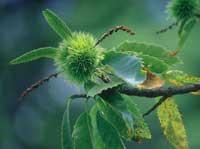The book, published by Julián Alustiza, gives us the loss of chestnut trees.
1999/12/01 Kortabarria Olabarria, Beñardo - Elhuyar Zientzia Iturria: Elhuyar aldizkaria

The book on the Basque hamlet, published in 1985 by Julián Alustiza, perfectly illustrates the loss of chestnut trees: "At some time there were large chestnut trees in Euskal Herria. (…) But the chestnut offered our courageous ancestors, especially for food. Little by little, Iztueta reminds us in his "legend of Gipuzkoa": "Gaztaiña has no gueon, no lacquer, no other problem, but to grab the bite, cook it in the pacific, or burn and eat in the frying pan".
(…) In the Basque countries many types of chestnuts were known. The most special of Gabiria:
a) The "castaña de Andra Mari" was the first to arrive. Very good edible. To sell in the area of Ordizia was a early morning. Eleven housewives met happy to then sell them on the market and correct the things that were desired for Andra Mari. b) «Azpeiti gaztaina». Nor was it an excuse for this type of chestnuts: it had a very nice grain, boar. Most of the time it was eaten cooked. d) «Bizkaia Chestnut»: the grain was very luxurious of morro. And the chestnut was sweet also to eat, although cooked, or asada.e) «Corn». This type of chestnuts would be the one that brought in our coffers the largest grain. The people were not abandoned. f) «Castaña de Elorri». Ona hau ere.g) «Kirrimahatsa». This type of chestnuts had a rather arid grain. However, to eat roasted in the tamboril.h) «Goat chestnut». Also the finest grain. It was always eaten roasted. And its grain was quite arid, it would not be boring in chestnuts, in order to fatten boars and others.
(…) However, our baserritarras preferred that chestnut for the kitchen. This chestnut does not mean much for today's young people. From time to time they will buy on the edges of the streets some chestnut kernels to enjoy the mouth. From there little.
At one time, however, the chestnut supplied many Basques of life. From the month of November to the month of March, at least, our dinners revolved around the chestnut. And what a pity!, moreover, we were exhausted too quickly.
Therefore, what the old Graciano reminds us is really interesting: "Our ammonia said that Father Palacios, in his sermons, said that castanets deserve to be treated with gold garlic. That this belly of the peasants is the best food and the cheapest one».
(…) Because, as we have written before, for four or five months our law of supper was the chestnut. Before the orchard soup or the porrusalda… The chestnut later, everything you wanted. Sometimes cooked, roasted other times. Young people will always prefer roasts. The older ones, for their part, adapt better to the cooked chestnuts. From there could arise some angry in the kitchen. However, they had a way of repair: The chestnuts would be delivered cooked until Christmas. And from that moment, since they had begun to close, better roasted.
(…) The old chestnut carried diseases. In the area of Navarra, however, we can still find good chestnuts. But I think that in these aspects they have been created a worse disease: the hunger for money. And their old and raw chestnuts go upside down… meals for the moors of the mountain bike.
(…) The bertsolari Uztapide expressed it little by little:
In his day of Gaztaiñaana,now there is Asia rising and ending with the concern of the daughter,is the pest.½

Gai honi buruzko eduki gehiago
Elhuyarrek garatutako teknologia





